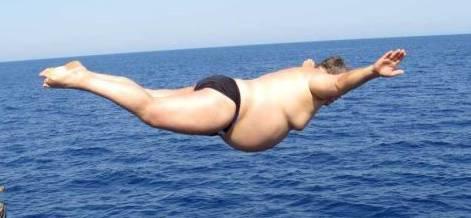
GREAT MEN: STOP FLYING

FT. Overweight oil workers will be barred from flying offshore, under new helicopter safety rules that could cause disruption to the North Sea oil industry.
The rule is among stipulations set out in a wide-ranging safety review of offshore helicopter operations by the Civil Aviation Authority that followed a spate of fatal ditchings and crashes.
But oil operators have given warning the regulations might end up being self-defeating, causing delays in crucial maintenance programmes for some North Sea rigs and platforms that could put offshore workers at increased risk of accidents.
Union officials are most concerned about the restrictions on oversize passengers, however. "There are a lot of big guys [in the industry] and ... this is going to prohibit a lot of [them] from going offshore," said Jake Molloy, regional organiser of the RMT union in Aberdeen. "It's the wrong approach."
Robert Paterson, health and safety director at Oil & Gas UK, said it would have a significant effect because offshore workers were 19 per cent heavier on average than 25-years-ago and 1.5cm-2cm taller. "Some people of larger build are in safety-critical roles offshore," he said.
A string of fatal accidents has heightened public scrutiny of the issue of helicopter safety in the offshore oil industry. Four oil workers were killed last August when their helicopter crashed off Shetland. In the wake of that incident, the CAA ordered a safety review, and its 293-page report was published in February.
In it, the CAA said that from April 1 2015, operators would be prohibited from carrying passengers who were too big to squeeze through the helicopter's windows, which are pushed out during a crash to form emergency exits.
But instead of forcing workers to slim down, Mr Molloy said the focus should instead be on increasing the number and size of the windows. "We need to look at how we can improve the safety routes," he said.
The CAA also stipulated that from June 1, no one will be allowed to sit in a seat not adjacent to a window or door unless they have been provided with specialist emergency breathing equipment, or unless the helicopter has been fitted with side-floats to reduce the risk of capsizing.
Currently, passengers are equipped with simple "rebreathers", which can be used before a helicopter is submerged. The plan is to replace these with "Category A" breathing apparatus – rather like aqualungs – which can be deployed underwater.
With less than two months to go, no such equipment has yet been approved for use, and no side-float technology is available. "The CAA jumped the gun on this," Mr Paterson said.
If neither measure is in place by the June 1 deadline, the CAA said, only passengers sitting next to windows would be allowed to fly. That would reduce the number of workers a helicopter could carry by about a third.
Oil executives are concerned the rules will come into effect just as the North Sea geared up for its annual programme of maintenance. Mr Paterson said there was a risk "safety critical" turnrounds would be affected by the reduction in seating capacity. "If we can't get people offshore to do them, some will have to be postponed till 2015," he said.
A spokesman for Total, the French oil company that has a huge presence in the North Sea, echoed the comments, saying the June 1 deadline would lead to "significant disruption".
Others are worried about the effect on productivity. "This is going to reduce the carrying capacity of the whole North Sea fleet," said an oil company chief executive. "To get 60 people on to a rig we will need five landings, rather than three."
North Sea crashes
July 2002 Sikorsky S-76A crashed into the North Sea near the Santa Fe Monarch rig and was destroyed following the failure of a main rotor blade. All 11 people on board were killed.
December 2006 Eurocopter AS365 seen to descend into the Irish Sea near Morecambe Bay, close to an offshore platform. All seven people on board were killed.
April 2009 Eurocopter Super Puma L2 crashed into the North Sea near Peterhead following gearbox failure and rotor head separation. All 16 passengers on board were killed.
August 2013 Eurocopter Super Puma L2 helicopter crashed in the sea a mile from Shetland airport, killing four of the 18 people on board and seriously injuring the pilot. This prompted the Civil Aviation Authority to launch a review looking specifically at helicopter airworthiness, training, seat layout and "operator decision making".





